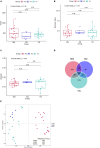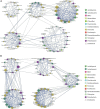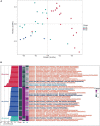A comprehensive comparison of fecal microbiota in three ecological bird groups of raptors, waders, and waterfowl
- PMID: 36003944
- PMCID: PMC9393522
- DOI: 10.3389/fmicb.2022.919111
A comprehensive comparison of fecal microbiota in three ecological bird groups of raptors, waders, and waterfowl
Abstract
Gut microbiota plays a vital role in maintaining the health and immunity of wild birds. However, less is known about the comparison of fecal microbiota between different ecological groups of wild birds, particularly in the Yellow River National Wetland in Baotou, China, an important transit point for birds migrating all over the East Asia-Australian and Central Asian flyways. In this study, we characterized the fecal microbiota and potential microbial function in nine bird species of raptors, waders, and waterfowl using 16S rRNA gene amplicon sequencing to reveal the microbiota differences and interaction patterns. The results indicated that there was no significant difference in α-diversity, but a significant difference in β-diversity between the three groups of birds. The fecal bacterial microbiota was dominated by Firmicutes, Proteobacteria, Actinobacteria, and Bacteroidetes in all groups of birds. Furthermore, we identified five bacterial genera that were significantly higher in raptors, five genera that were significantly higher in waders, and two genera that were more abundant in waterfowl. The bacterial co-occurrence network results revealed 15 and 26 key genera in raptors and waterfowls, respectively. The microbial network in waterfowl exhibited a stronger correlation pattern than that in raptors. PICRUSt2 predictions indicated that fecal bacterial function was significantly enriched in the antibiotic biosynthesis pathway in all three groups. Metabolic pathways related to cell motility (bacterial chemotaxis and flagellar assembly) were significantly more abundant in raptors than in waders, whereas waders were enriched in lipid metabolism (synthesis and degradation of ketone bodies and fatty acid biosynthesis). The fecal microbiota in waterfowl harbored more abundant vitamin B6 metabolism, RNA polymerase, and tyrosine and tryptophan biosynthesis. This comparative study revealed the microbial community structure, microbial co-occurrence patterns, and potential functions, providing a better understanding of the ecology and conservation of wild birds. Future studies may focus on unraveling metagenomic functions and dynamics along with the migration routine or different seasons by metagenomics or metatranscriptomics.
Keywords: co-occurrence network; fecal microbiota; metabolic pathways; raptors; waders; waterfowl.
Copyright © 2022 Zhao, Liu, Gao and Bai.
Conflict of interest statement
The authors declare that the research was conducted in the absence of any commercial or financial relationships that could be construed as a potential conflict of interest.
Figures





Similar articles
-
Seasonal variation in gut microbiota of migratory wild raptors: a case study in white-tailed eagles.Anim Microbiome. 2025 Apr 17;7(1):37. doi: 10.1186/s42523-025-00406-y. Anim Microbiome. 2025. PMID: 40247417 Free PMC article.
-
Comparative analysis of the fecal microbiota in Père David's deer and five other captive deer species.Front Microbiol. 2025 Mar 26;16:1547348. doi: 10.3389/fmicb.2025.1547348. eCollection 2025. Front Microbiol. 2025. PMID: 40207150 Free PMC article.
-
Comparative analysis of the gut microbiota of wild wintering whooper swans (Cygnus Cygnus), captive black swans (Cygnus Atratus), and mute swans (Cygnus Olor) in Sanmenxia Swan National Wetland Park of China.Environ Sci Pollut Res Int. 2023 Sep;30(41):93731-93743. doi: 10.1007/s11356-023-28876-0. Epub 2023 Jul 29. Environ Sci Pollut Res Int. 2023. PMID: 37515622
-
Comparative Analysis of the Gut Microbial Communities of the Eurasian Kestrel (Falco tinnunculus) at Different Developmental Stages.Front Microbiol. 2020 Dec 18;11:592539. doi: 10.3389/fmicb.2020.592539. eCollection 2020. Front Microbiol. 2020. PMID: 33391209 Free PMC article.
-
Comparative analysis of the fecal microbiota of healthy and injured common kestrel (Falco tinnunculus) from the Beijing Raptor Rescue Center.PeerJ. 2023 Aug 22;11:e15789. doi: 10.7717/peerj.15789. eCollection 2023. PeerJ. 2023. PMID: 37637157 Free PMC article.
Cited by
-
Seasonal variation in gut microbiota of migratory wild raptors: a case study in white-tailed eagles.Anim Microbiome. 2025 Apr 17;7(1):37. doi: 10.1186/s42523-025-00406-y. Anim Microbiome. 2025. PMID: 40247417 Free PMC article.
-
Comparative analysis of the intestinal microbiota of black-necked cranes (Grus nigricollis) in different wintering areas.Front Cell Infect Microbiol. 2024 Jan 22;13:1302785. doi: 10.3389/fcimb.2023.1302785. eCollection 2023. Front Cell Infect Microbiol. 2024. PMID: 38317791 Free PMC article.
-
Tracheal and cloacal bacterial diversity of red listed Eastern Imperial Eagle (Aquila heliaca).Front Microbiol. 2025 May 9;16:1477032. doi: 10.3389/fmicb.2025.1477032. eCollection 2025. Front Microbiol. 2025. PMID: 40415931 Free PMC article.
-
Comparative analysis of the fecal microbiota in Père David's deer and five other captive deer species.Front Microbiol. 2025 Mar 26;16:1547348. doi: 10.3389/fmicb.2025.1547348. eCollection 2025. Front Microbiol. 2025. PMID: 40207150 Free PMC article.
-
Falcon gut microbiota is shaped by diet and enriched in Salmonella.PLoS One. 2024 Jan 30;19(1):e0293895. doi: 10.1371/journal.pone.0293895. eCollection 2024. PLoS One. 2024. PMID: 38289900 Free PMC article.
References
-
- Benson A. K., Kelly S. A., Legge R., Ma F., Low S. J., Kim J., et al. (2010). Individuality in gut microbiota composition is a complex polygenic trait shaped by multiple environmental and host genetic factors. Proc. Natl. Acad. Sci. U.S.A. 107 18933–18938. 10.1073/pnas.1007028107 - DOI - PMC - PubMed
LinkOut - more resources
Full Text Sources

